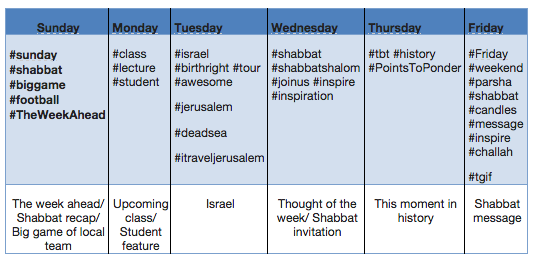
This article assumes that you’ve already read Parts 1 and 2 of the NLEResources.com introduction to Instagram (linked immediately below) and you or your program are working with an Instagram account.
Part 1: Everything a Rabbi and Educator Needs to Know About Instagram
Part 2: Everything a Rabbi and Educator Needs to Know About Instagram.
Now it’s time to bring it all together by talking tachlis. Since most (read all) of us in the kiruv world are busy, adding another social media platform is probably the last thing on our mind. No worries. This article will give some practical tips to easily use each aspect of Instagram and integrate it into your overall social media strategy—from creating or choosing the right hashtags to community engagement and increasing your Instagram followers.
Strategy
My chaver and colleague, Rabbi Ozzie Burnham, was right when he said that having a mehalech or strategy for Instagram is important. In fact, it’s true for all social media from Facebook to Twitter to Vine. These platforms don’t exist in a vacuum. They are only good if viewed from the perspective of one message, one voice across the board.
Consistency is critical.
Honestly, it’s easier to create one global digital strategy than to create multiple ones, especially for people in the trenches of campus outreach. The question is how to craft a digital strategy that’s good for Instagram that can also be used for other channels?
Caveat: Pick 1-2 social channels and own them. Using all of them will not work. It’s a bechina of ‘tafasta meruba’ (trust me I’ve tried).
Assume that social media is being used as a tool to engage college students, get them excited about Judaism, and invite them to all types of kiruv programming including Shabbos, Yontif, classes, events and to explore Israel.
Here’s a good strategy for leveraging social media, similar to something I’ve worked on with other clients in the space. First, create an overview of your monthly schedule for each academic semester. For example, the chart below provides an overview of a typical fall semester:
Step 1: Semester View
Step 2: Weekly View
Once we know the monthly calendar, let’s drill down to the weekly schedule. Assign each day a different aspect of a typical (if there is such a thing) on-campus experience.
Each week the strategy should be to provide one post per day, per platform. Each post should provide value to the students or audience. No more than one post per week should be a ‘hard sale.’ Meaning one post can be a direct link to a sign-up page.
The rest of the posts are to add value to yourself and your organization in your audience’s eyes. Value in this case means explaining the significance of an upcoming Yontif, wishing them good luck on tests, highlighting some quotes or personalities from a recent class, or sending Israel images.
Here’s a sample weekly schedule:

Now the entire semester is planned! All that’s left to do is to pre-schedule content.
Content can be images, quotes, or videos. Here are some samples from the pros on campus of what this actually looks like: NYU mentions their primary # in their bio on Instagram.
This enables anyone to tag the school easily and on a Google search of the # content will come up across the digital channels. Notice that some of their content leverages several existing conversations in the digital sphere, like #tbt:
Queens University used #queensu as their branded hashtag and then integrated it to encourage students to submit content that describes or depicts their experience on campus:
The Frosh Week countdown is almost over! Who’s excited to arrive at #queensu? #queensu2018 A photo posted by queensuniversity (@queensuniversity) on
Brocks University used Instagram to encourage more people to sign a petition:
A photo posted by Brock University (@brockuniversity) on
Ideally, all of the content should direct the students back to a home, like a website and include a call to action that makes them respond in some way. Even on Instagram, calls to action can be:
● ‘Like’ to show your appreciation
● Tell us you want to come for Shabbos by clicking ‘like’
● Click the link in the bio to sign up for the best Israel experience
Instagram can easily be pre-scheduled using apps like Onlypult, Latergramm or Crowdfire.
3 Pro Tips for Strategy Creation
1. Use the ‘off season’ to pre-record or pre-write the content. The Parshiot/ Yomim Tovim never change, nor do their messages.
2. Scheduling posts is great. On special occasions or in extenuating circumstances (lo aleinu) make sure to interrupt the regular schedule to focus on the situation at hand (keep the passwords and process available at all times).
3. Respond. If you’re going to use a social media platform, don’t just post. Make sure to be responsive to current events (shouldn’t take more than 5-10 minutes per day).

Hashtags
It’s been discussed previously (see the NLEResources.com article entitled, How to Pick a Jewish Hashtag: The Power of Social Media) how hashtags are great ways to increase reach and engagement on certain social platforms. While all social platforms allow hashtags, the most common ones that are acceptable are Instagram and Twitter. In either case, however, overdoing it is considered spam. So finding the most relevant hashtags is very important.
How does a campus program or outreach professional find the best ones?
It’s easier than you think.
Step 1: Think about the keywords that best describe your work.
Jewish, campus, college, Israel, classes, inspire, community, Judaism, enrichment, rabbi.
Step 2: Search similar hashtags or variations
Use sites like this to find popular hashtags along with some apps that can help with the initial boost.
You can use up to 30 hashtags per Instagram post. Use a few in the original post and add more in the comments. Use some of the common ones. You can create your own, but don’t go crazy. Make sure that someone else hasn’t claimed it by checking it on Tagboard.
Pro Tip: Start by using the common hashtags for growth. While #MEORROCKSTHEHOUSE may be true (not an actual #), no one is actually looking for that one. Sorry.
Step 3: Use the hashtag on all visuals and other promotional content.
If you want to get the hashtag to stick, then the key to a solid Instagram and digital strategy is consistency. Cross promoting the hashtag informs your followers that this is what they should use when they share their images or content. People should see the same hashtag on Instagram, on a poster in the cafe or on their kipa.
Step 4: Use hashtags that are easy to read and understand
If you’re using a one-word hashtag, don’t capitalize, #parsha is fine. With multiple words, maximize readability by capitalizing each word, e.g., #OnegShabbatTonight.
How this integrates into our schedule

Community, Engagement and Growth
Who are the people in your Instagram community?
The answer is simple — your students, alumni and friends. Don’t be afraid to ask them for their Instagram profile or seek them out by using the Instagram search feature. Engage your community by offering valuable content (see above) and by asking for their input when you post new content.
Here are some Instagram growth tips:
1. User generated content. Ask your students to submit content using a unique hashtag (not a generic one) so that it’s easier for you to share or repost it. Get them to submit some of their thoughts on the Parsha or holiday.
2. Run a contest. Here’s another great way to engage your students or participants. Ask them to send or tag you in a meaningful contest using Instagram as the main platform for content submission. Example: send us your best #SukkaSelfie and you could win…..
3. Optimize your Instagram profile. The infographic below (that originates from here) gives practical advice on creating an Instagram profile to increase your Instagram followers:

I hope this simple tachlis-oriented strategy brings you much hatzlacha on Instagram. Can’t wait to see your snaps!
I’m here to discuss any Instagram or social media-related questions.
Mordecai Holtz is the Co-CEO of Blue Thread Marketing a boutique digital marketing firm working with brands from startups to cities. Prior to Blue Thread, Mordecai worked for several kiruv organizations to oversee their Israel trips and overall operations.
Mordecai is available for consultation by email or Twitter on how to leverage your organization’s or campus kiruv program. You can find Mordecai on Instagram here.




















